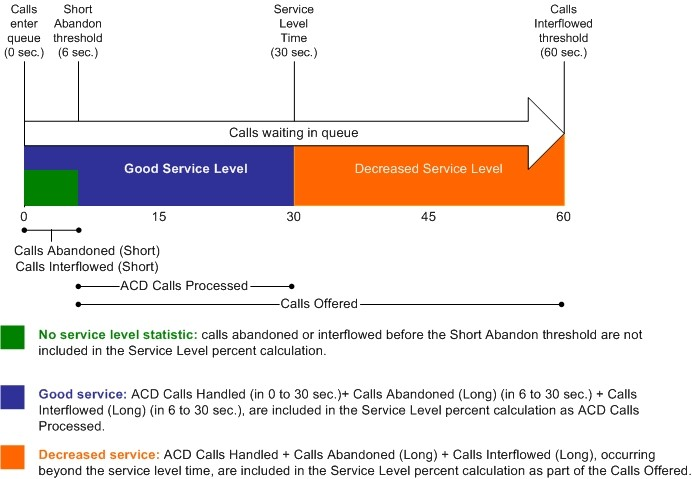Understanding The Service Level
Why is Service Level the standard measurement of service? Service Level provides the most accurate representation of the clients' experience; it is ultimately the client who decides what constitutes good service, and whether or not to end a contact (call, email, chat, or SMS). It applies to inbound transactions that must be addressed as they arrive.
When a contact enters a queue, the contact is processed in one of three ways:
- The contact is answered or opened (handled contact).
- The client disconnects before the contact is answered (abandoned contact) (calls and chats only).
- The contact is removed from the queue, and sent to another handling point (for example, to voice mail, an automated attendant, or another queue), (interflowed contact).
Understanding the following terms will help you determine your Service Level objective:
Offered
All contacts received by the ACD queue, regardless of how they are handled or routed, are referred to as offered contacts. Offered contacts include ACD handled contacts, abandoned (long) contacts, and interflowed contacts. ACD requeued contacts, Queue unavailable contacts, and abandoned (short) contacts are not considered.
Abandoned
An abandoned contact is a contact terminated before being answered. An abandoned chat is one that does not reach an agent because the client ended the chat session before the agent opened it. Abandoned statistics are not applicable to email and SMS.
Abandoned (long) contacts end with an abandon time > Short Abandon. You define the Short Abandon you want under YourSite=>Queues=>Performance tab. The Short Abandon default is 6 seconds. If a customer terminates the contact hangs after waiting 7 seconds, the contact is considered a long abandon. Long abandon contacts are included in report statistics.
Abandoned (short) contacts end with an abandon time <= Short Abandon. You define the Short Abandon you want under YourSite
=>Queues=>Performance tab. The Short Abandon default is 6 seconds. For example, if a customer terminates the contact after waiting just 6 seconds or less, the contact is considered a Short Abandon. Short Abandon contacts are not included in call statistics.
lnterflowed
lnterflow refers to a mechanism that directs a contact in queue to another answering point. For example, a call sent from one queue to another queue or to voicemail is interflowed. In reporting, the interflowed statistic represents the total number of contacts removed from a queue and sent to another queue or alternate answer point. This includes contacts transferred manually from the queue. Contacts routed to other answering points before the Short Abandon threshold are not included in Interflow statistics.
The system can interflow a contact for several reasons, including
- The interflow time for the contact is exceeded.
- The interflow time for the contact is predicted to exceed the interflow time.
- A client chooses the Dial Out of Queue option, which removes the contact (calls only) from the queue and sends it to a predefined answering point.
NOTE: The Dial Out of Queue feature is a user-initiated interflow feature. A Dial Out of Queue call is considered to be an interflowed call, and is pegged as a Calls Interflowed statistic in reports.
Handled
A handled contact is a contact that has been opened or, in the case of calls, answered. Calls that listen to in-queue RAD messages are not considered to be handled until a queue member connects.
Service Level Time
The Service Level Time is the threshold time used in calculating the Queue Service Objective. For example, your Queue Service Objective may require queue members to handle 80% (Service Level Percent) of contacts within 120 seconds. Queue Service Objectives are configured on individual queues, in YourSite Explorer. The default Service Level Time for calls and multimedia contacts = 120 seconds.
Service Level Count
Service Level Count = The number of contacts sent to the queue that were handled, abandoned, or interflowed within the specified Service Level time, as configured in YourSite Explorer.
Service Level Percent
Service Level Percent = Service Level Count + ACD offered
For calls and chats, the Service Level Percent is the number of contacts that are handled, abandoned, and interflowed before a defined threshold time (Service Level time), compared to the total number of contacts handled, abandoned, and interflowed. The Service Level Percent = (Handled + Abandoned (long) + lnterflowed (long)) within the Service Level time + Total (Handled + Abandoned (long) + lnterflowed (long)).
For email and SMS, the Service Level Percent is the number of contacts that are handled and interflowed before a defined threshold time (Service Level time), compared to the total number of contacts handled and interflowed. The Service Level Percent = (Handled + lnterflowed (long)) within the Service Level time + Total (Handled + lnterflowed (long)).
ln Figure 2, the Service Level Objective is to handle 80% of contacts within 30 seconds. The contacts waiting in queue for 60 seconds are routed to voice mail.
Figure 2: Service Level Percent
NOTE:
When you manually redirect (drag and drop) a call in Interactive Visual Queue, MiContact Center changes the way the call is pegged on the Queue Performance reports. If you redirect a call before the short abandon time set for the queue, the call is pegged as Unavailable. If you redirect a call after the short abandon time set for the queue, the call is pegged as lnterflowed.